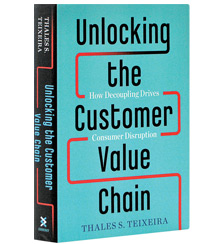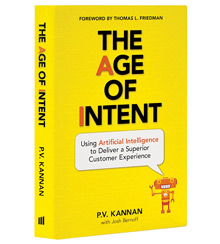Best Business Books 2019: Marketing
Thriving in a complex and expanding ecosystem.
Thales S. Teixeira
Unlocking the Customer Value Chain: How Decoupling Drives Consumer Disruption (with Greg Piechota; Currency, 2019)
*A TOP SHELF PICK
P.V. Kannan
The Age of Intent: Using Artificial Intelligence to Deliver a Superior Customer Experience (with Josh Bernoff; Amplify, 2019)
Bruno Gralpois
Agency Mania: Harnessing the Madness of Client/Agency Relationships for High-Impact Results (2nd ed.) (Beaufort Books, 2019)
With each passing year, the universe of marketing and sales continues to expand. Fueled by technology, constant connectivity, and rapidly evolving consumer behavior, the scope of activities and competencies that fall under this category grows. This year’s three best business books on marketing come from three radically different parts of the ecosystem — and each reimagines a core function while expanding the boundaries of the discipline. Whether they are suggesting new ways to consider the customer experience, providing a realistic look at the immense potential of artificial intelligence, or delving into the still-powerful role of agencies, this year’s books bring focus to an industry that increasingly defies easy definition.
In this age of revolutionary change, many of us are seeking a Grand Theory of Everything, something that explains phenomena as seemingly disparate as ride-sharing services, meal-prep kits, and streamed entertainment. Each of these is a new industry, thriving within a much larger industry. Each would have sounded outlandish 15 years ago. But they have all gained traction, and have changed the way consumers go about their daily lives.
Unlocking the Customer Value Chain, by Thales S. Teixeira, has hit on as grand (and accurate) a theory as any book I’ve read over the last several years. The book — this year’s best — is a thought-provoking look at what’s really leading to all this innovation. And, no, it’s not technology. That’s just an enabler. As Teixeira, a professor of business administration at Harvard Business School, explains, the book “presents a new approach to digital disruption, one rooted not in a study of technology or business strat-egy generally, but in the disciplines of marketing and consumer behavior.”
Teixeira contends that most of the new business successes we see today are the result of a specific kind of disruption: the fracturing of the traditional customer value chain (CVC) into more specialized offerings that simply work better for today’s consumers. The simplest version of the CVC has four steps: Evaluate > Choose > Purchase > Consume. In the case of ride-sharing companies such as Lyft, the CVC — which once might have included the purchase of a car for general transportation needs — now simply focuses on the act of getting to a destination. Meal-prep kit companies such as Blue Apron obviate the need for home cooks to go to the grocery store and evaluate, choose, and purchase ingredients; rather, they focus only on people’s interest in preparing meals at home. For many consumers of filmed entertainment, streaming has decoupled video from cable television (except for the Internet connection, which we’ll revisit shortly).
All of these observations are interesting, certainly. But whether you’re an aspiring disruptor or an incumbent in danger of being disrupted, the reason to read Unlocking the Customer Value Chain is that it can help you identify decoupling even before it’s happening. Teixeira has observed five steps decouplers take, regardless of industry, from identifying a target market and its CVC to predicting how incumbents might respond to disruption — if you decide you want to launch a subscription cosmetics business, what might Estée Lauder do about it? The decoupling steps “address a key customer need — namely, a desire to specialize — by reducing the customer’s costs [time, money, and effort] of acquiring products and services.”
For disruptors, breaking apart the value chain creates an immense opportunity. But those being disrupted don’t always respond as today’s marketplace demands. Rather than prepare for a future state, they instinctively protect their turf even if it hurts their customers. Teixeira retells the instructive tale of the 2015 battle between Comcast and Netflix. Comcast, concerned that Netflix was cutting into its core cable television business, demanded that Netflix pay for some of the Internet bandwidth it was eating up on behalf of its customers. When Netflix CEO Reed Hastings balked, Comcast slowed down those customers’ access to Netflix. Hastings paid up, briefly, so his customers wouldn’t be affected. But in his view, Netflix was driving demand for Comcast’s high-margin Internet service. Maybe Comcast needed to pay Netflix, he mused. Eventually a truce was called. But Teixeira notes, “[Comcast] had lost sight of its customers’ ultimate needs for reliable entertainment, communication, and information.”
Comcast committed the cardinal error of this disruptive age. Rather than doing what was right for its customers, it made them pawns. There’s a reason it’s called the customer value chain.
The AI solution
One of the bedrock principles of choosing the best business books of the year on marketing is to be wary of any book that touts a specific technology. No one wants to look in the rearview mirror and see that “the next big thing” actually wasn’t.
But I have no hesitation in recommending The Age of Intent, by P.V. Kannan (with Josh Bernoff). Kannan describes intent as “the fundamental unit of interaction for a virtual agent system.” The first step in activating such a system is defining a list of intents — such as finding a store or scheduling a technician visit — that a virtual agent can respond to quickly.
Kannan, whose company, [24]7.ai, builds virtual agent services for marketers, has a highly vested interest in touting the rise of chatbot-inspired artificial intelligence (AI). But rather than use his book solely to advocate for AI, Kannan consistently discusses both its warts and its wonders. Early on, he prints a verbatim conversation his coauthor had with an Expedia chatbot that was having trouble recognizing the location “New York, N.Y.” When an exasperated Bernoff finally types: “You’re pretty stupid,” the clueless chatbot responds, “OK, what city do you want to stay in?”
On the flip side, Kannan is quick to point out early successes. A decision by Dish Network to automate a third of its most common customer intents has led its system DiVA (Dish virtual agent) to now be capable of handling 40 percent of customer questions.
Kannan’s balanced approach to the topic is why readers will come away from the book convinced that, despite some hiccups, customer service chatbots are the future. For one thing, they scale. Many companies would be hard-pressed, for instance, to hire hundreds of extra customer service reps to meet spikes in demand. But virtual agents can scale up on the fly. No on-boarding, training, free snacks, or additional pay is needed.
Many companies would be hard-pressed to hire hundreds of extra customer service reps to meet spikes in demand. But virtual agents can scale up on the fly. No on-boarding, training, free snacks, or additional pay is needed.
Obvious? Perhaps. But throughout The Age of Intent, Kannan goes deeper with his insights. Yes, cost reduction is one rationale for deploying chatbots. But to truly be worth the investment, companies must think more expansively about their potential. Simply using them to funnel incoming customer service calls to the right agent is a necessary but not sufficient step. Kannan stresses that virtual agents need to play a variety of integrated front- and back-end roles. “[Digital customer service] demands a system smart enough to connect to all the company’s customer databases, one that answers questions on weekends and holidays, scales up to meet demand, and supports human agents when human agents are the best customer service solution,” he writes.
Indeed, Kannan doesn’t think the rise of the chatbot will lead to the end of the human customer rep; rather, he believes they will work together, with the bot, say, providing key information on a customer to the human or taking care of simpler customer service issues so the professionals can move on to more nuanced concerns that bots aren’t capable of handling. Kannan has also thought through the implications of marketers employing chatbots at a time when some of this activity is moving over third-party platforms, such as Facebook Messenger or Amazon’s Alexa. He cautions marketers to be careful about who is listening. “Why would you let a rival eavesdrop as you serve your customers?” he asks.
Immersing yourself in The Age of Intent lets you in on the thinking of a true expert in an emerging field. Buy it, read it, and become a human well-armed for the chatbot future.
The human factor
At the beginning of one chapter in Agency Mania, author Bruno Gralpois urges the reader to “go ahead and grab a cup of coffee” before plunging into a 40-page treatise on client/agency contracts. And it shouldn’t be a shot of espresso. Agency Mania is not a book that most readers will finish in one gulp; its best use is as a comprehensive manual detailing virtually every aspect of the client/agency relationship, to be kept on the office bookshelf (or iPad) and pulled out (or tapped on) as needed. About to look for a new agency? Read chapter 5, “Assortative Mating and the Sweaty T-Shirt Theory: Conducting a Successful Agency Search.” Trying to figure out an equitable compensation model? Turn to chapter 7, “Just Six Numbers: Determining the Right Agency Compensation.” Quotes interspersed throughout from major advertisers and agencies — Procter & Gamble, Anomaly, Ford — enhance the book’s credibility. Charts and best practices listed at the end of each chapter help break the thick book into digestible chunks.
Many marketing books I’ve read over the years have been inspiring. Many of the treatises and cris de coeur of ad gurus are full of soaring rhetoric and stabs at deeper meaning. Agency Mania is not one of these books. It’s a distinctly unromantic look into the plumbing of marketing. That said, you’re unlikely to find a more essential book if, as is the case for many marketers, your relationship with your agency is the most important one in your work life. Gralpois, a consultant who has championed agency management as a discipline top advertisers need to invest in, leaves no aspect of the client/agency relationship undiscussed. He devotes dense chapters to scoping work and briefing agencies, building effective performance evaluations, and understanding the nuances of that strange place still sometimes referred to as Madison Avenue.
And make no mistake — an agency isn’t just any vendor. It’s not like the relationship a company has with its accountants or its legal firm. In the words of ad pioneer Leo Burnett, who is quoted early in the book, “The work of an advertising agency is warmly and immediately human. It deals with human needs, wants, dreams, and hopes. Its ‘product’ cannot be turned out on an assembly line.”
Because agencies and clients have been stuck in their sometimes awkward dance for decades, you may wonder why this book is so timely now. Shouldn’t marketers be fluent in these issues already? The fact is that, with all due respect to Mad Men, the client/agency relationship as depicted in popular culture couldn’t be more of an anachronism. Where agency compensation once was merely a matter of calculating 15 percent of the media budget and paying that amount to the agency, compensation now tends to be fee-based. And although some agencies enjoy retainers, it’s increasingly popular for clients to hire agencies for projects, or to incentivize agencies by tying compensation to results, a model that has come into some favor as marketing has become more measurable.
The range of services that agencies provide to clients has changed too. Yes, the focus is still on leveraging creative and media expertise to build marketing efforts. In the past, that might have been creating a catchy campaign; commissioning a zippy jingle; and producing ads for TV, print, and radio. Today an agency might do all that, but it will also likely advise a client on how it can build a cheeky reputation on Twitter, partner with a nonprofit that fits with the marketer’s mission, embed sustainability into its products, or use TV advertising as support for a mobile experience where consumers can buy the product.
The fact that there is no longer a templated approach to marketing has had ripple effects in every aspect of the business. A client may have to hire multiple agencies to execute a single campaign, with each bringing its own expertise to the party. It may draw on an agency’s or holding company’s data to carve out specific targets, or it may have an in-house agency that doles out project work on occasion to external partners. Even as marketing has gotten more complex, the hard and necessary work of fostering the client/agency relationship is often overlooked. Gralpois writes, “It’s perplexing that while an agency is often a company’s single largest marketing expense, and one of the most powerful and competitive weapons at a company’s disposal, there are no formal rulebooks and few guidelines being followed on how to effectively make the best out of this unique type of partnership.” Indeed. Agency Mania is a step in that direction.
This year’s best business books on marketing as a group may not have universal appeal. The entrepreneur looking for a breakthrough business idea may love Unlocking the Customer Value Chain but have no reason to learn the ins and outs of client/agency contracts. Similarly, the CMO about to embark on an agency search may dive deep into Agency Mania, but hand The Age of Intent over to the customer service team. Regardless, thriving in marketing today requires adapting and understanding best practices in a range of disciplines. Wherever you sit in today’s crowded and occasionally befuddling marketing ecosystem, you’ll find a helpful guide in this trio.
Author profile:
- Catharine P. Taylor is U.S. commissioning editor for WARC. She has covered digital media since 1994, writing for publications including Adweek and Advertising Age. She also wrote the weekly Social Media Insider column for MediaPost for seven years.







